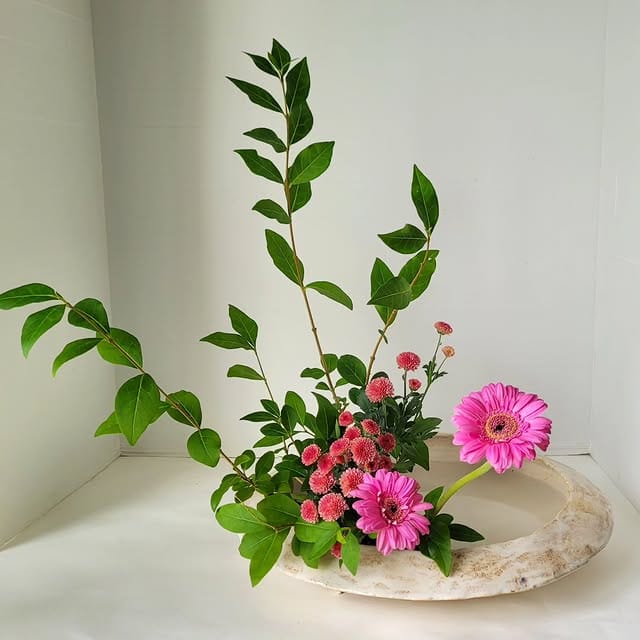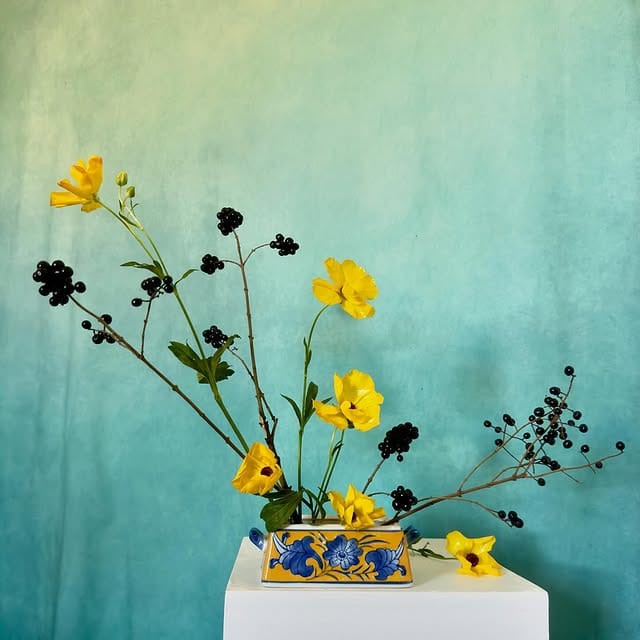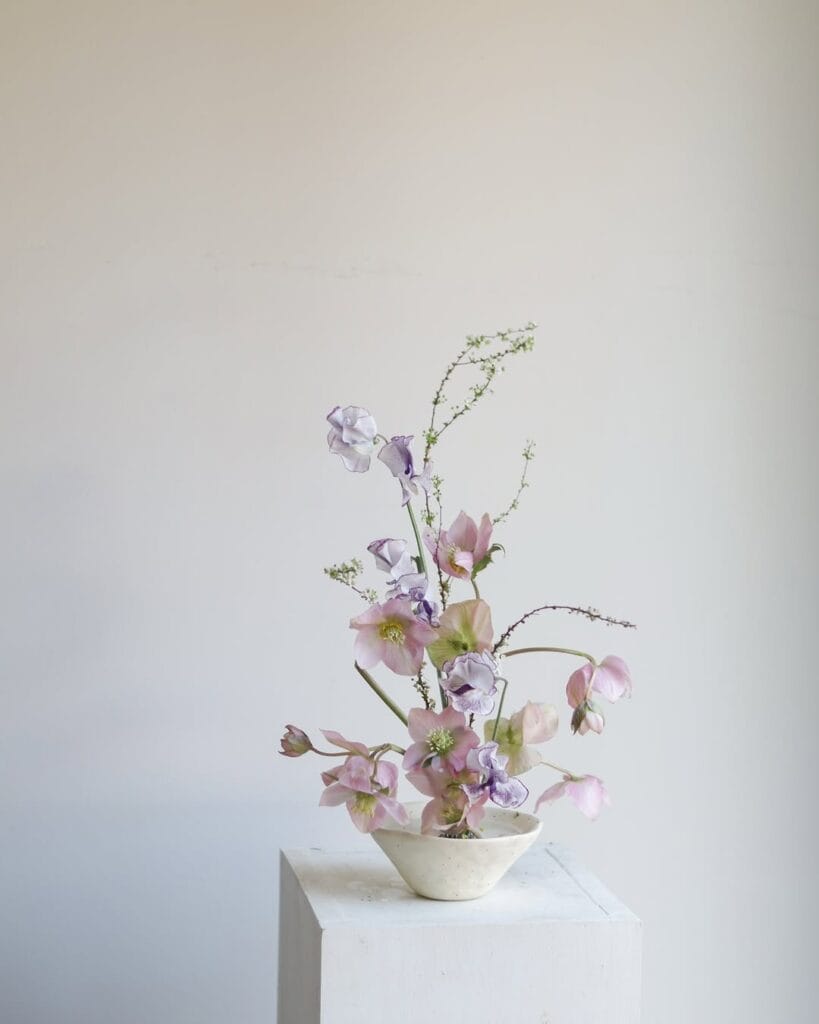I’ll be honest – when I first heard about ikebana, I thought it was going to be one of those intimidating traditional arts that requires years of study and perfect technique. But then I actually tried it, and it’s become my favorite way to slow down and create something beautiful. It’s like meditation with flowers, and way more accessible than you’d think.
Ikebana is the Japanese art of flower arrangement, but it’s so much more than just “making flowers look pretty.” It’s about finding balance, embracing negative space, and creating harmony between different elements. Sounds deep, right? It is, but it’s also surprisingly calming and doesn’t require a PhD in floristry.

What Makes Ikebana Different
Unlike Western flower arranging where we tend to go for full, abundant displays, ikebana is all about restraint and intentionality. Every stem has a purpose, every angle matters, and the empty spaces are just as important as the filled ones.
It’s not about using tons of flowers – in fact, traditional ikebana often uses just a few carefully chosen stems. The focus is on the natural beauty of each element and how they work together to create something greater than the sum of their parts.
The Basic Philosophy (Without the Overwhelm)
Three Main Elements:
- Shin (Heaven): The tallest element, usually the main structural piece
- Soe (Human): The middle height, provides balance and support
- Hikae (Earth): The shortest element, grounds the arrangement
Key Principles:
- Asymmetry: Balance without being perfectly symmetrical
- Negative Space: The empty areas are part of the design
- Natural Movement: Follow the natural growth patterns of plants
- Seasonal Awareness: Use what’s naturally available
Don’t stress about memorizing all this – the best way to learn is by doing.
Getting Started: What You Actually Need
Essential Supplies:
- Kenzan (Pin Holder): The spiky metal disc that holds stems in place
- Suiban (Shallow Bowl): Traditional low, wide container
- Sharp Floral Scissors: For clean cuts
- Small Watering Can: For adding water carefully
Budget-Friendly Alternatives:
- Use a low, wide ceramic bowl instead of traditional suiban
- Floral foam can work instead of kenzan for practice
- Any sharp scissors will do to start
- A small measuring cup works for adding water
Where to Find Supplies:
- Japanese import stores
- Online (Amazon has basic sets)
- Some craft stores carry kenzan
- Thrift stores for interesting containers

Simple Styles to Try First
Moribana (Piled-Up Flowers): This is the most beginner-friendly style. You arrange flowers in a shallow container with water, focusing on creating natural-looking groupings.
Basic Triangle Formation:
- Place your tallest stem (shin) at an angle
- Add a medium stem (soe) to balance
- Add a short stem (hikae) to ground the arrangement
- Fill in with smaller elements if desired
Seasonal Approach:
- Spring: Cherry blossoms, tulips, fresh green branches
- Summer: Hydrangeas, lilies, bold foliage
- Fall: Chrysanthemums, maple branches, ornamental grasses
- Winter: Pine, bamboo, camellias, bare branches

Beginner-Friendly Flower Choices
Easy to Work With:
- Chrysanthemums (mums)
- Lilies
- Carnations
- Daffodils
- Iris
Great Branch Options:
- Pussy willow
- Forsythia
- Curly willow
- Flowering quince
- Simple green branches
Foliage That Works:
- Hosta leaves
- Ferns
- Eucalyptus
- Aspidistra (cast iron plant)
Start with sturdy flowers that hold their shape and don’t wilt immediately. You can get fancy later.

Your First Arrangement: Step by Step
Materials Needed:
- 3-5 stems of different heights
- Kenzan and shallow bowl
- Water
- Sharp scissors
The Process:
- Prep Your Container: Place kenzan in bowl, add water to just cover the base
- Choose Your Main Stem: This will be your tallest element (shin)
- Make the Cut: Cut at an angle under running water for better water uptake
- Place the Shin: Insert firmly into kenzan at about a 15-degree angle
- Add the Soe: Medium height stem, placed to create balance
- Ground with Hikae: Shortest stem, usually placed in front
- Step Back and Assess: Look at the overall balance and adjust
Don’t overthink it – trust your instincts about what looks balanced.

Common Beginner Mistakes (And How to Avoid Them)
Using Too Many Flowers: Less is more in ikebana. Start with 3-5 stems total and see how much you can express with minimal materials.
Ignoring the Container: The vase or bowl is part of the design. Choose something that complements your flowers without competing.
Forcing Symmetry: Ikebana is about dynamic balance, not perfect symmetry. Let things feel natural and flowing.
Neglecting Negative Space: The empty areas are just as important as the filled ones. Don’t feel like you need to fill every gap.
Rushing the Process: Ikebana is meant to be meditative. Take your time and enjoy the process of creating.
Finding Your Style
Minimalist Approach: Focus on one or two types of flowers with lots of negative space. Very zen and modern.
Seasonal Celebration: Use whatever’s naturally available in your area. Cherry blossoms in spring, colorful leaves in fall.
Modern Interpretation: Mix traditional principles with contemporary flowers and containers. Think orchids in sleek ceramic vessels.
Garden-to-Vase: Use what you can grow or forage. This connects you to the natural cycles that inspire ikebana.
The Meditative Aspect
This is honestly why I fell in love with ikebana. The process of selecting stems, considering their natural growth patterns, and carefully placing each element is incredibly calming. It forces you to slow down and pay attention to details you’d normally miss.
There’s something magical about working with living materials and finding the perfect balance between structure and natural beauty. It’s creative problem-solving with a zen twist.
Making It Sustainable
Care for Your Arrangements:
- Change water every 2-3 days
- Trim stems regularly
- Remove wilted flowers to keep the arrangement fresh
- Some arrangements can last 1-2 weeks with proper care
Composting: All your materials are biodegradable, making this an eco-friendly art form.
Seasonal Sourcing: Using seasonal, local materials reduces environmental impact and connects you to your local ecosystem.
Where to Learn More
Books:
- “The Art of Ikebana” by Shozo Sato
- “Ikebana: The Art of Arranging Flowers” by Susan Conder
Online Resources:
- Ikebana International (local chapters worldwide)
- YouTube tutorials for visual learners
- Instagram accounts for daily inspiration
Local Classes:
- Japanese cultural centers
- Community colleges sometimes offer classes
- Botanical gardens often have workshops
The Bottom Line
Ikebana isn’t about creating perfect arrangements – it’s about developing a relationship with natural materials and finding beauty in simplicity. Your first attempts might not look like museum pieces, and that’s totally fine. The practice itself is where the magic happens.
I’ve found that even 15 minutes of ikebana practice can shift my entire mood. It’s like a mini-meditation session that leaves you with something beautiful to look at.
The best part? You don’t need to be an expert to enjoy it. Start with a few stems from your garden or the grocery store, find a shallow bowl, and just begin. Let the process teach you what you need to know.



